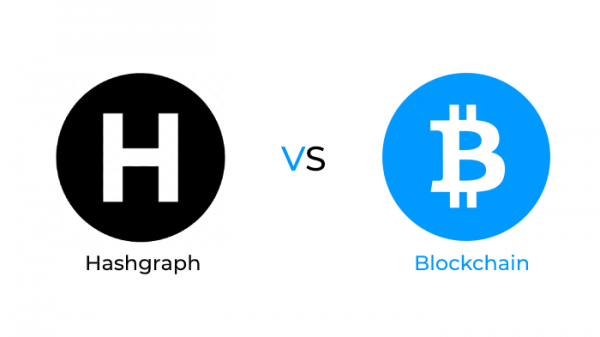
Hedera Hashgraph vs Blockchain – A Comparison
SubscribeBlockchain is often hailed as one of the most revolutionary technologies of the 21st century. It is actually a distributed ledger technology that enables users to interact through the network and arrive at a consensus. Distributed ledger technology (DLT) provides simultaneous access and document updating of various entities in a reliable and immutable way. But blockchain is not the only distributed ledger technology around. Hashgraph or Hedera Hashgraph is a similar technology that has gained popularity recently. It claims to be more reliable, effective, and faster than blockchain. Here we will compare the two distributed ledger technologies, what they mean, how they differ, and much more.
What is Blockchain?
Blockchain is the most popular form of DLT. Its most common use case has been as the underlying technology behind cryptocurrencies. Blockchain is a P2P, decentralized DLT that records transactions without the help of any third parties. The data is stored safely in blocks, and once entered data cannot be tampered with in any way.
Blockchain technology provides increased transparency, immutability, privacy, and security to users. But recently, transaction speeds have been an issue in popular blockchain networks such as Bitcoin and Ethereum due to the increase in the number of users.
Explore more to find out the difference betweenPublic Blockchain vs Private Blockchain Services
What is Hedera Hashgraph?
Hedera Hashgraph is a public DLT that employs the fast, reliable, and highly secure Hashgraph consensus mechanism. Hashgraph offers an alternative approach to the distributed ledger technology offering security and decentralization using hashing. It can produce results similar to blockchain, but with better energy efficiency, stability and security.
Hashgraph can process thousands of transactions per second, thereby overcoming the transaction speed limitations of blockchain. Algorithms Gossip about Gossip and virtual voting is used to sustain connectivity and consensus. Hedera Hashgraph has its own cryptocurrency HBAR, used to develop P2P payment systems, dApps, micropayment solutions, etc…
Also Read What Is Crypto Margin Trading And How Does It Work?Services
Blockchain vs Hedera Hashgraph – A Comparison
Transaction speed
The Gossip about Gossip protocol is used by Hashgraph for transactions. This protocol needs less information to progress even if many events are taking place, considerably speeding up the transactions. Hedera Hashgraph can provide transaction speeds of up to 500,000 transactions per second.
The transaction speed of a blockchain depends on the protocol implemented, the purpose of the transaction, etc. However, transaction speeds are significantly low compared to that of Hashgraph. Blockchains can provide only slow to medium transaction speeds of about 100 to 10,000 transactions per second.
Security
Blockchain and Hashgraph are both solid in terms of security. Blockchain uses cryptographic methods and Hashgraph employs Asynchronous Byzantine Fault Tolerance (aBFT). The digital blocks in the blockchain are tamper-proof and if someone tries to meddle with the data, the whole block will become invalid.
In Hashgraph, each event is recorded correctly, and completed transactions cannot be altered in any way. It has modified aBFT to provide better security against 51% and DDoS attacks.
Consensus algorithm
There are multiple approaches to consensus in blockchain depending on the platform. Proof of work, proof of stake, proof of elapsed time, delegated BFT, etc… are some of the consensus algorithms used in blockchain.
Virtual voting is used to attain consensus in Hedera Hashgraph. As Hashgraph itself can be considered a low-cost and high-performance consensus algorithm, no other algorithms are required.
Efficiency
Blockchain mining is not very efficient for miners. Blocks can often get discarded, and their efforts wasted. Hedera Hashgraph does not use the block system, and hence these problems do not exist. Resources are not wasted at all.
Transaction fees
The transaction fees in the different blockchain platforms are higher compared to Hedera Hashgraph. The average transaction fee in Bitcoin is $2.99 at the time of writing. While in Ethereum it is $2.5. Hedera Hashgraph offers a very cheap transaction fee of $0.0001.
Computing power and energy
Blockchain is notorious for the computing power and electricity consumption required for mining. The global bitcoin network presently devours about 80 terawatt-hours of electricity per year. This is about 0.55% of the global electricity consumption and is similar to the annual electricity consumption of some countries. High computing power is also required in the blockchain. Hedera Hashgraph does not consume enormous quantities of electricity or require tremendous computing power.
Read more onSha256 Algorithm – Best Cryptocurrency Hashing Algorithm Services
Conclusion
Hedera Hashgraph provides better transaction speeds compared to blockchains. Both technologies are solid in terms of security. While blockchain uses different consensus systems depending on the platform, virtual voting is used in Hashgraph. Hedera Hashgraph is more efficient, charges fewer transaction fees, and requires lesser computing power and energy.
Although Hashgraph is a promising technology, it also has certain limitations. It is yet to be tested widely and explored in a public network. Hedera Hashgraph is an intriguing technology with lots of potentials, but it has a lot of ground to cover to measure up to blockchain.
- What is Cryptojacking? Detection and Preventions Techniques
- How to Give Cryptocurrency As a Gift?
- Blockchain Development Life Cycle – Step by Step Guide
- How To Hire A Blockchain Developer For Your Company
- How to Choose the Right Bitcoin Development Company – A Complete Guide
- Common Bitcoin Scams – Beware Of Fraudsters
- How can entrepreneurs leverage blockchain in 2023?
- Role of Blockchain in Cyber Security
- Document and Certificate Verification Through Blockchain Technology
- Initial Coin Offering (ICO): Everything you need to know in 2023
- Categories
- Azure Blockchain Service
- Bitcoin
- Bitcoin Development
- Blockchain Application
- Blockchain Application Development
- blockchain developer
- Blockchain Development
- common bitcoin scams
- Crypto software features
- Crypto softwares
- Cryptocurrency
- Cryptocurrency Development
- Cryptocurrency Exchange Software Development
- Cryptocurrency review
- Cryptocurrency Trading
- Cryptocurrency Wallet Development
- ERC20 Token Development
- Hashing Algorithm
- ICO Development
- ICO Development Service
- ico website development
- Proof of Stake Coins
- Smart Contract Development
- Uncategorized











Leave a Reply